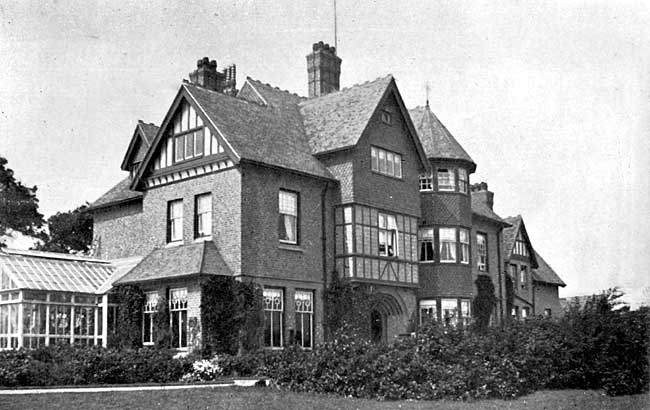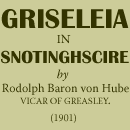< Previous | Contents | Next >

Cloverlands, home of the Hansons.
That framework knitting was much in vogue throughout the Parish of Greasley is evident from the Marriage and Baptism Register of the Parish, but whether the Luddite movement of frame-breaking did mischief here we know not, but framework knitting continued here long after. There were frames worked at Newthorpe and Moorgreen as late as 1868 and some time after.
Of Shoemakers there was a large supply throughout the Parish, though not so much as now of dressmakers. Does not the latter show that the people are very much better off, and that they are able to renew their garments much oftener than 50 or even 25 years ago?
Mechanics too have increased throughout the Parish, though few of them are perhaps now as in olden times more or less versed in all branches of their trades.
Some of the latest industries of Kimberley are the lace works, which give occupation to many; and Mr. Ths. Bayley has established a leatherboard manufacture at the Giltbrook Tannery, which occupies from 150 to, we believe, 200 hands of the weaker sex. It is an industry in the process of which we were much interested when looking over the establishment, not the least agreeable impression made on us there was, the silent busy working of those engaged there, and the considerate and kindly treatment which they receive.
Lastly, though their establishment belongs to an earlier period we must mention the Kimberley Breweries. The oldest of them was that of Mr. Robert Goodall Hanson, a County Councillor, and for many years of uninterrupted succession Chairman of the Board of Guardians. His brewery had in process of time to be greatly enlarged, and the lucrative business is now the property of a limited liability company, of which Messrs. Hanson and Sons are the chief shareholders directing the business. Mr. Hanson has built a fine and commodious house for his family residence in Newdigate Lane, to which he has given the name “Cloverlands.”
 Hardy & Hanson's brewery, Kimberley (Photo:
A Nicholson, 2002).
Hardy & Hanson's brewery, Kimberley (Photo:
A Nicholson, 2002).The other brewery was started by the late Messrs. Thomas and William Hardy, and was equally prosperous. Upon Mr. William Hardy’s retirement Mr. Thomas Hardy considerably enlarged the establishment, which is now also the property of a limited liability company, of which the family are chief shareholders and we believe directors. Mr. Thomas Hardy a few years before his demise purchased Bulwell Hall and the estate thereto belonging (together with the advowson of the parish church of Bulwell), which hall is now the family residence.
The parish of Greasley was, territorially speaking, the largest in the county, being about 20 miles in circumference, and having in one direction and another not less than 9 miles high road. The population of Kimberley in one direction, and that of Brinsley in another, had greatly increased, and the populations lay so widely scattered and so far asunder that the provision of a church, with a churchyard and parsonage, at Kimberley, had become a necessity. When that was accomplished Kimberley was, on the 11th October, 1848, by an Order of Her Majesty in Council in the Isle of Wight, constituted a district parish. It was provided however, that the ecclesiastical fees of the new parish should be retained by the then vicar of the mother church to the close of his incumbency. Under this arrangement the style of the incumbent of Kimberley was that of a perpetual curate. After the demise of the then vicar of Greasley the fees became due to the incumbent of Kimberley, who then became a vicar. Subsequently an Act was passed which gave the title of rector to any incumbent who should recover or secure some tithes for his benefice, and the first vicar of Kimberley having done that to the extent of some £20 per annum, Kimberley became once more a rectory, as in its earliest church times it had been.
The first incumbent of the new parish was the Revd. William St. George Sargent, after whose demise we, on the recommendation of a late dear friend, presented the Revd. Alexander Roberts, M.A., to the rectory, and on the latter’s resignation it was gratifying to us to present the Revd. Frederick Hart, B.A., the present incumbent, to the rectory. Since 1848, and especially 1870 odd, the parish of Kimberley has vastly progressed and increased. Not only has the town of Kimberley itself much increased, in commerce and population, but also in large and comely structures; and westward of it a new considerable township has sprung up, which may well be denominated “New Kimberley.” Still further west, on Gilthill, Hilltop, the Brook Hills, and Newthorpe Common, the population has also considerably increased and the localities are becoming increasingly thriving ones.
The boundaries of the new parish of Kimberley, as described in the above quoted Order in Council, are as follows :— “The Chapelry District of Kimberley is bounded on the north-west by the parish of Eastwood, on the west by the parish of Ilkeston, on the south-west by the township of Awsworth (which is a detached part of the parish of Nuthall) and by the parish of Cossall, on the south by the parish of Strelley, on the east by the said parish of Nuthall, on the north by the remaining part of the parish of Greasley, from which such Chapelry District of Kimberley is separated, by proceeding in a northwesterly direction up the middle of the road leading from Nuthall to Greasley, as far as Holly Lane, up the middle of which lane it proceeds westerly as far as the boundary line separating the hamlets of Kimberley and Watnall Canteloupe, along which boundary it proceeds north-westerly to the boundary of the hamlets of Moorgreen and Kimberley, along which boundary it then proceeds westerly as far as Giltbrook, and then turns southerly down that brook as far as the road from Kimberley and Nottingham to Eastwood, along the middle of which road it then proceeds northwesterly as far as the parish of Eastwood, and including in the said Chapelry District of Kimberley a certain detached portion of the said parish ‘of Greasley called Hempsill, which is bounded on the north and north-west by the said parish of Nuthall, on the east and north-east by the parish of Bulwell, on the south-east by the parish of Basford, and on the south by the parish of Bilborough.”
